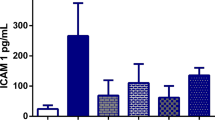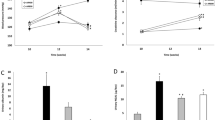Abstract
Ischemia reperfusion (I/R) injury which causes kidney dysfunction is one of the most studied diseases directly linked to oxidative stress. In this regard, it is important to protect cells against damage by inducing antioxidant response. Herein, we aimed to evaluate the therapeutic roles and possible mechanisms of propolis and boric acid in kidney I/R injury based on relevant basic research and clinical studies. Sprague-Dawley rats were subjected to 50 min of ischemia followed by 3 h of reperfusion. Animals were randomly divided into a control group (the abdominal wall was just opened and closed), an I/R injury group, the propolis intervention group (200 mg/kg, intragastric administration, 1 h before ischemia), boric acid intervention group (14 mg/kg, intragastric administration 1 h before ischemia), and the propolis + boric acid intervention group (intragastric administration 1 h before ischemia). Kidney function, the antioxidant defensive system, and renal damage were assessed. In addition, the oxidative stress and inflammatory status were estimated in renal tissue. Furthermore, DNA damageand apoptosis were detected by immunohistochemistry. When compared with I/R group, propolis alone and especially propolis + boric acid groups significantly improved functional parameters. While the antioxidant response was increased, renal injury size and apoptosis were significantly decreased in both groups. Also, the MDA and TNF-α levels besides the 8-OHdG formation were downregulated. According to these outcomes, it can be said that especially propolis together with boric acid ameliorates kidney injury caused by I/R through acting as an antioxidant, anti-inflammatory, and antiapoptotic agent. In conclusion, propolis alone and its combination with boric acid could be developed as therapeutic agents against serious renal I/R injuries.



Similar content being viewed by others
References
Ito R, Kumada Y, Ishii H, Kamoi D, Sakakibara T, Umemoto N, Takahashi H, Murohara T (2018) Clinical outcomes after isolated infrapopliteal revascularization in hemodialysis patients with critical limb ischemia: endovascular therapy versus bypass surgery. J Atheroscler Thromb 25:799–807
Xu Z, Dai C (2017) Ablation of FGFR2 in fibroblasts ameliorates kidney fibrosis after ischemia/reperfusion injury in mice. Kidney Dis 3:160–170
Goetz L, Laskowski J, Renner B, Pickering MC, Kulik L, Klawitter J, Stites E, Christians U, van derVlag J, Ravichandran K, Holers VM, Thurman JM (2018) Complement factor H protects mice from ischemic acute kidney injury but is not critical for controlling complement activation by glomerular IgM. Eur J Immunol 1
Cheungpasitporn W, Khoury NJ, Thongprayoon C, Craici IM (2017) Is remote ischemic conditioning of benefit to patients undergoing kidney transplantation? J Investig Surg 12:1–3
Song Y, Liu W, Ding Y, Jia YY, Zhao J, Wang F, Bai J, Cheng L, Gao K, Liu M, Yao M, Li L, Zhang Y, Wen A, He L (2018) Salvianolic acid A ameliorates renal ischemia/reperfusion injury by activating Akt/mTOR/4EBP1 signaling pathway. Am J Physiol Renal Physiol 315:F254–F262
Martinotti S, Bucekova M, Majtan J, Ranzato E (2018) Honey: an effective regenerative medicine product in wound management. Curr Med Chem. https://doi.org/10.2174/0929867325666180510141824
Farooqui T, Farooqui AA (2012) Beneficial effects of propolis on human health and neurological diseases. Front Biosci (Elite Ed) 4:779–793
Bankova V, Popova M, Trusheva B (2018) The phytochemistry of the honeybee. Phytochemistry 24(155):1–11
Patel S (2016) Emerging adjuvant therapy for cancer: propolis and its constituents. J Diet Suppl 13(3):245–268
Nzietchueng RM, Dousset B, Franck P, Benderdour M, Nabet P, Hess K (2002) Mechanisms implicated in the effects of boron on wound healing. J Trace Elem Med Biol 16(4):239–244
Barranco WT, Eckhert CD (2006) Cellular changes in boric acid-treated DU-145 prostate cancer cells. Br J Cancer 94:884–890
Hakki SS, Bozkurt BS, Hakki EE (2010) Boron regulates mineralized tissue-associated proteins in osteoblasts (MC3T3-E1). J Trace Elem Med Biol 24:243–250
Vijay Bhasker T, Gowda NKS, Krishnamoorthy P, Pal DT, Sejian V, Awachat VB, Verma AK (2017) Boron supplementation provides hepato-protective effect and improves performance in Wistar rats fed calcium deficit diet. Indian J Anim Sci 87(10):1213–1218
Moseman RF (1994) Chemical disposition of boron in animals and humans. Environ Health Perspect 102:113–117
WHO; Environ HealthCriteria Document No. 204 (1998): Boron (7740-42-8) p.53
Acar Ü, İnanan BE, Zemheri F, Kesbiç OS, Yılmaz S (2018) Acute exposure to boron in Nile tilapia (Oreochromis niloticus): median-lethal concentration (LC50), blood parameters, DNA fragmentation of blood and sperm cells. Chemosphere 213:345–350
Gheisari A, Shahrvand S, Landy N (2017) Effect of ethanolic extract of propolis as an alternative to antibiotics as a growth promoter on broiler performance, serum biochemistry, and immune responses. Vet World 10:249–254
Bahadoran H, Naghii MR, Mofid M, Asadi MH, Ahmadi K, Sarveazad A (2016) Protective effects of boron and vitamin E on ethylene glycol-induced renal crystal calcium deposition in rat. Endocr Regul 50(4):194–206
Choi DE, Jeong JY, Lim BJ, Chung S, Chang YK, Lee SJ, Na KR, Kim SY, Shin YT, Lee KW (2009) Pretreatment of sildenafil attenuates ischemia-reperfusion renal injury in rats. Am J Physiol Renal Physiol 297(2):F362–F370
Yıldırım S (2017) Investigation by histopathological and TUNEL method of the protective effect of resveratrol on carbon tetrachloride induced liver toxicity in rats. Ataturk Univ J Vet Sci 12:178–186
Bovo E, Mazurek SR, Zima AV (2018) Oxidation of ryanodine receptor following ischemia/reperfusion increases propensity of Ca2+ waves during β-adrenergic receptor stimulation. Am J Physiol Heart Circ Physiol 315(4):H1032–H1040
Cao H, Ou J, Chen L, Zhang Y, Szkudelski T, Delmas D, Daglia M, Xiao J (2018) Dietary polyphenols and type 2 diabetes: human study and clinical trials. Crit Rev Food Sci Nutr 11:1–19
Puspasari A, Harijanti K, Soebadi B, Hendarti HT, Radithia D, Ernawati DS (2018) Effects of topical application of propolis extract on fibroblast growth factor-2 and fibroblast expression in the traumatic ulcers of diabetic Rattus norvegicus. J Oral Maxillofac Pathol 22(1):54–58
da Costa MF, Libório AB, Teles F, Martins Cda S, Soares PM, Meneses GC, Rodrigues FA, Leal LK, Miron D, Silva AH, Martins AM (2015) Red propolis ameliorates ischemic-reperfusion acute kidney injury. Phytomedicine 22(9):787–795
El-Marasy SA, Abdel-Rahman RF, Abd-Elsalam RM (2018) Neuroprotective effect of vildagliptin against cerebral ischemia in rats. Naunyn Schmiedeberg’s Arch Pharmacol 391(10):1133–1145
Tanaka A, Ito Y, Kawasaki H, Kitabayashi C, Nishioka R, Yamazato M, Ishizawa K, Nagai T, Hirayama M, Takahashi K, Yamamoto T, Araki N (2018) Effects of memantine on nitric oxide production and hydroxyl radical metabolism during cerebral ischemia and reperfusion in mice. J Stroke Cerebrovasc Dis 27(6):1609–1615
Lungkaphin A, Pongchaidecha A, Palee S, Arjinajarn P, Pompimon W, Chattipakorn N (2015) Pinocembrin reduces cardiac arrhythmia and infarct size in rats subjected to acute myocardial ischemia/reperfusion. Appl Physiol Nutr Metab 40(10):1031–1037
Aldahmash BA, El-Nagar DM, Ibrahim KE (2016) Reno-protective effects of propolis on gentamicin-induced acute renal toxicity in swiss albino mice. Nefrologia 36(6):643–652
Mounieb F, Ramadan L, Akool ES, Balah A (2017) Propolis alleviates concanavalin A-induced hepatitis by modulating cytokine secretion and inhibition of reactive oxygen species. Naunyn Schmiedeberg's Arch Pharmacol 390(11):1105–1115
Ince S, Keles H, Erdogan M, Hazman O, Kucukkurt I (2011) Protective effect of boric acid against carbon tetrachloride-induced hepatotoxicity in mice. Drug Chem Toxicol 15:1–8
Yazıcı S, Akşit H, Korkut O, Sunay B, Çelik T (2014) Effects of boric acid and 2-aminoethoxydiphenyl borate on necrotizing enterocolitis. J Pediatr Gastroenterol Nutr 58(1):61–67
Hu X, Ma R, Lu J, Zhang K, Xu W, Jiang H, Da Y (2016) IL-23 promotes myocardial I/R injury by increasing the inflammatory responses and oxidative stress reactions. Cell Physiol Biochem 38(6):2163–2172
Tanko Y, Kabiru A, Abdulrasak A, Mohammed KA, Salisu AI, Jimoh A, Gidado NM, Sada NM (2017) Effects of fermented ginger rhizome (Zingiber officinale) and Fenu Greek (Trigonella foenum-graceum) supplements on oxidative stress and lipid peroxidation biomarkers in Poloxamer-407 induced -hyperlipidemic Wistar rats. Niger J Physiol Sci 32(2):137–143
Mahalakshmi A, Kurian GA (2018) Evaluating the impact of diabetes and diabetic cardiomyopathy rat heart on the outcome of ischemia-reperfusion associated oxidative stress. Free Radic Biol Med 118:35–43
Cakir S, Eren M, Senturk M, Sarica ZS (2017) The effect of boron on some biochemical parameters in experimental diabetic rats. Biol Trace Elem Res 184(1):165–172
Luo YP, Zhang H, Hu HF, Cao ZY, Zhang XZ, Cao L, Wang ZZ, Xiao W (2017) Protective effects of Ginkgo terpene lactones meglumine injection on focal cerebral ischemia in rats. Zhongguo Zhong Yao Za Zhi 42(24):4733–4737
Cao J, Jiang L, Zhang X, Yao X, Geng C, Xue X, Zhong L (2008) Boric acid inhibits LPS-induced TNF-alpha formation through a thiol-dependent mechanism in THP-1 cells. J Trace Elem Med Biol 22(3):189–195
Yılmaz S, Ustundag A, Cemiloglu Ulker O, Duydu Y (2016) Protective effect of boric acid on oxidative DNA damage in Chinese hamster lung fibroblast V79 cell lines. Cell J 17(4):748–754
Türkez H, Geyikoğlu F, Tatar A, Keles MS, Kaplan I (2012) The effects of some boron compounds against heavy metal toxicity in human blood. Exp Toxicol Pathol 64:93–101
Ince S, Kücükkurt I, Demirel HH, Acaröz DA, Akbel E, Ciğerci IH (2014) Protective effects of boron on cyclophosphamide induced lipid peroxidation and genotoxicity in rats. Chemosphere 108:197–204
Jiang Y, Liu J, Zhou Z, Liu K, Liu C (2018) Fangchinoline protects against renal injury in diabetic nephropathy by modulating the MAPK signaling pathway. Exp Clin Endocrinol Diabetes 126:1–7
Castaldo S, Capasso F (2002) Propolis, an old remedy used in modern medicine. Fitoterapia 73:1–6
Kitamura H, Saito N, Fujimoto J, Nakashima KI, Fujikura D (2018) Brazilian propolis ethanol extract and its component kaempferol induce myeloid-derived suppressor cells from macrophages of mice in vivo and in vitro. BMC Complement Altern Med 18(1):138
Frión-Herrera Y, Díaz-García A, Ruiz-Fuentes J, Rodríguez-Sánchez H, Maurício Sforcin J (2018) Mechanisms underlying the cytotoxic effect of propolis on human laryngeal epidermoid carcinoma cells. Nat Prod Res 32(17):2085–2091
Rauch J, Kolch W, Laurent S, Mahmoudi M (2013) Big signals from small particles: regulation of cell signaling pathways by nanoparticles. Chem Rev 113(5):3391–3406
Durick KA, Tomita M, Hunt C, Bradley D (2005) Evidence that boron down-regulates inflammation through the NF-KB pathway. J Federation Am Soc Exp Biol 19(5):A1705
Armstrong TA, Spears JW, Lloyd KE (2001) Inflammatory response, growth, andthyroid hormone concentrations are affected by long-term boron supplementation in gilts. J Anim Sci 79:1549–1556
Armstrong TA, Spears JW (2003) Effect of boron supplementation of pig diets on theproduction of tumor necrosis factor-α and interferon-γ. J Anim Sci 81:2552–2561
Fry RS, Brown TT, Lloyd KE, Hansen SL, Legleiter LR, Robarge WP et al (2011) Effect of dietary boron on physiological responses in growing steersinoculated with bovine herpesvirus type-1. Res Vet Sci 90:78–83
Schumer M, Colombel MC, Sawczuk IS, Gobé G, Connor J, O'Toole KM, Olsson CA, Wise GJ, Buttyan R (1992) Morphologic, biochemical, and molecular evidence of apoptosis during the reperfusion phase after brief periods of renal ischemia. Am J Pathol 140(4):831–838
Cornara L, Biagi M, Xiao J, Burlando B (2017) Therapeutic properties of bioactive compounds from different honeybee products. Front Pharmacol 28(8):412
Pérez-Rodríguez M, García-Mendoza E, Farfán-García ED, Das BC, Ciprés-Flores FJ, Trujillo-Ferrara JG, Tamay-Cach F, Soriano-Ursúa MA (2017) Not all boronic acids with a five-membered cycle induce tremor, neuronal damage and decreased dopamine. Neurotoxicology 62:92–99
Ugwu DI, Okoro UC, Ahmad H (2017) New carboxamide derivatives bearing benzenesulphonamide as a selective COX-II inhibitor: design, synthesis and structure-activity relationship. PLoS One 12(9):e018380
Author information
Authors and Affiliations
Corresponding author
Ethics declarations
Experiments were performed according to the Guide for the Care and Use of Laboratory Animals published by the US National Institutes of Health (NIH publication No. 85-23, revised 1996). All experimental procedures in this study were approved by the Atatürk University Local Ethics Committee for Animal Experiments (No. 66, 22.03.2018).
Conflict of Interest
The authors declare that they have no conflict of interest.
Additional information
Publisher’s Note
Springer Nature remains neutral with regard to jurisdictional claims in published maps and institutional affiliations.
Rights and permissions
About this article
Cite this article
Geyikoglu, F., Koc, K., Colak, S. et al. Propolis and Its Combination with Boric Acid Protect Against Ischemia/Reperfusion-Induced Acute Kidney Injury by Inhibiting Oxidative Stress, Inflammation, DNA Damage, and Apoptosis in Rats. Biol Trace Elem Res 192, 214–221 (2019). https://doi.org/10.1007/s12011-019-1649-2
Received:
Accepted:
Published:
Issue Date:
DOI: https://doi.org/10.1007/s12011-019-1649-2




